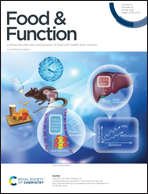Protein acidification and hydrolysis by pepsin ensure efficient trypsin-catalyzed hydrolysis†
Abstract
Enzyme-catalysed hydrolysis is important in protein digestion. Protein hydrolysis is initiated by pepsin at low pH in the stomach. However, pepsin action and acidification happen simultaneously to gastric emptying, especially for liquid meals. Therefore, different extents of exposure to the gastric environment change the composition of the chyme that is emptied from the stomach into the small intestine over time. We assessed the susceptibility of a protein to trypsin-catalysed hydrolysis in the small intestine, depending on its pH and hydrolysis history, simulating chyme at different times after the onset of gastric emptying. Isothermal titration calorimetry was used to study the kinetics of pepsin and trypsin-catalysed hydrolysis. Bovine serum albumin (BSA) that was acidified and hydrolysed with pepsin, showed the highest extent and most efficient hydrolysis by trypsin. BSA in the chyme that would be first emptied from the stomach, virtually bypassing gastric acidity and peptic action, reduced trypsin-catalysed hydrolysis by up to 58% compared to the acidified, intact protein, and 77% less than the acidified, pepsin-hydrolysate. The least efficient substrate for trypsin-catalysed hydrolysis was the acidified, intact protein with a specificity constant (kcat/Km) nearly five times lower than that of the acidified, pepsin-hydrolysate. Our results illustrate the synergy between pepsin and trypsin hydrolysis, and indicate that gastric hydrolysis increases the efficiency of the subsequent trypsin-catalysed hydrolysis of a model protein in the small intestine.



 Please wait while we load your content...
Please wait while we load your content...